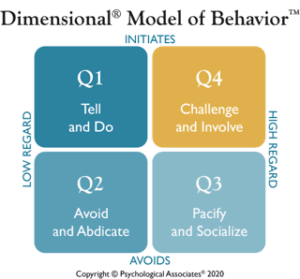Are You Being as Open-Minded as You Think You Are?
What happens when you think you are doing everything right in managing your direct report, but you’re still not getting results? You are getting his views first before presenting your own. You are asking open-end questions. The problem must be the direct report, right? Maybe. But there is another possibility that we’ll explore in this case study. Could it be that you have a blind spot — that although you think your communication is entirely Q4, you may just be missing something? Is it possible that your open-end questions are not as open as you think — and that your issue is how to avoid leading questions?
The Situation
Bart is in charge of product development for an outdoor furniture manufacturer. One of his direct reports, Nick, is a project manager, responsible for bringing new products from testing phase to market launch.
Although Nick’s projects go smoothly, they never come in on time. Bart and Nick have discussed the reasons for this with each project, but there has been little improvement. Now, Bart wants to talk with Nick to get to the source of the problem. He suspects Nick doesn’t break down his projects into enough specific action steps and doesn’t use the company’s process management software to its best advantage.
To help Nick to be candid and open, Bart resists speaking up first or stating his own opinions. Instead, he uses open-end probes to encourage Nick to speak.
Probing Questions Example
Here are several of his probes:
“Nick, how do you go about breaking down your goal for a project into action steps?”
“What’s your opinion of the software we use for project management?”
“Tell me how you think these tools could help you stay on schedule.”
When Your Open Ended Questions Aren’t Working
Nick answers in full detail. By the end of the conversation, Bart elicits Nick’s commitment to give more thought to action steps and be more diligent using the software.
After several more projects, delays are still a problem.
For the purpose of analyzing Bart’s approach, what could Bart have done differently in getting Nick’s views of the problem and ideas for solving it? After all, he felt he used a Q4 responsive and collaborative questioning style.

How to Avoid Leading Questions
As we stress in the our Q4 Leadership workshops, open–end probes are one of your best tools for exploring another person’s views.
Benefits of Open-End Questions
Open-end questions invite a broad response, coaxing the other person to expand on the subject. They get the other person involved in the conversation, and show you respect his thinking. Isn’t this what Bart did?
Yes, he asked open-end questions and gave Nick full opportunity to speak. However…
Leading Questions
Unwitting or not, Bart steered the conversation to his own ideas for overcoming the delays, i.e., more specific action steps and better use of software tools.
It’s important to understand that simply using open probes doesn’t automatically surface the right issues. Although open, Bart’s probes narrowed the field of responses too quickly. Thus, he missed the opportunity to discover along with Nick what was actually happening in the process to cause delays. Without realizing it, Bart was asking leading questions.
Non Leading Questions
How to avoid asking leading questions? Bart could have begun more broadly:
“Nick, when a new product comes to you, what is your usual procedure?”
“Take me through the steps of a typical project and your view of time requirements for each.”
“What do feel are your biggest time problems as you move to the launch date?”
When you probe in a Q4 open-minded way, it’s not just a matter of asking questions that get the other person talking. You goal is to encourage a willingness to open up and promote trust so that the answers are honest and not tainted by your own views.
In this case, Nick might suspect that his difficulty in prioritizing tasks is the reason projects fall behind. He has anxiety about something falling through the cracks. So, he personally verifies the most minute details. But Nick isn’t likely to discuss his behavior unless he feels comfortable, and Bart’s probes make it easy to avoid this. By not getting the right issues out on the table, how likely is it they can collaborate to change the situation?
Loaded Questions
Leading questions, suggestive questions, biased questions, loaded questions,… Whatever you call them, these may be effective if you are cross-examining a witness in the courtroom. But in the workplace when you are trying to problem-solve and motivate an employee to change their behavior, it is not enough to let your employee give their views first and ask open-end questions. You have to make sure that your questions don’t box him in to give you the answers you want to hear. That is Q1 behavior, disguised as Q4. You may get some short term compliance. But to get sustained, long term results — to get true commitment — make sure you are not asking leading questions.
Additional Leadership Resources for You
So now you’re aware of a common managerial blindspot. You have learned how to avoid leading questions. What’s next?
Our Leadership Learning page offers over 40 additional tips/case studies for handling common managerial situations. We invite you to complete our behavior questionnaire where you’ll get actionable tips on how to deal with that difficult person at work.
If you are ready to apply your leadership skills and improve your business results, check out our leadership development resources. You’ll find info on our Q4 Leadership workshops, coaching, 360 feedback, and more.
And if you do not already receive our monthly newsletter, the Q4 Connection, be sure to sign up. You’ll get leadership tips, upcoming events, and more delivered right to your inbox.
Here’s to your further leadership development!













